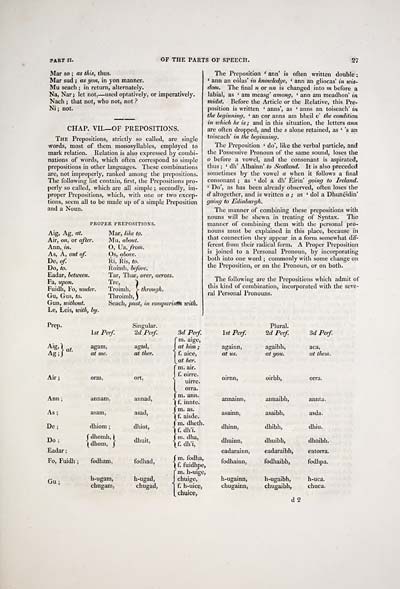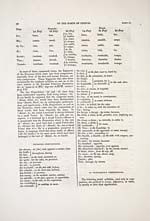Download files
Complete book:
Individual page:
Thumbnail gallery: Grid view | List view

OF THE PARTS OF SPEECH.
27
Mar so ; as this, thus.
Mar sud ; as yon, in yon manner.
Mu seach ; in return, alternately.
Na, Nar ; let not, — used optatively, o
Nach ; that not, who not, not ?
Ni; not.
CHAP. VII.— OF PREPOSITIONS.
The Prepositions, strictly so called, are single
words, most of them monosyllables, employed to
mark relation. Relation is also expressed by combi-
nations of words, which often correspond to simple
prepositions in other languages. These combinations
are, not improperly, ranked among the prepositions.
The following list contain, first, the Prepositions pro-
perly so called, which are all simple ; secondly, im-
proper Prepositions, which, with one or two excep-
tions, seem all to be made up of a simple Preposition
and a Noun.
PROPER PREPOSITIONS.
Tlie Preposition ' ann' is often written double :
' ann an eòlas' in knowledge, ' ann an gliocas' in wis-
dom. The final n or nn is changed into m before a
labial, as ' am measg' among, ' ann am meadhon' in
midst. Before the Article or the Relative, this Pre-
position is written ' anns', as ' anns an toiseach' in
the beginning, ' an cor anns am bheil e' the condition
in which he is; and in this situation, the letters ann
are often dropped, and the s alone retained, as ' 's an
toiseach' in the beginning.
The Preposition ' do', like the verbal particle, and
the Possessive Pronoun of the same sound, loses the
o before a vowel, and the consonant is aspirated,
thus ; ' dh' Albainn' to Scotland. It is also preceded
sometimes by the vowel a when it follows a final
consonant ; as ' dol a dh' Eirin' going to Ireland.
' Do', as has been already observed, often loses the
d altogether, and is written a ; as ' dol a Dhuneidin'
goiiiff to Edinburgh.
The manner of combining these prepositions with
nouns will be shewn in treating of Syntax. The
manner of combining them with the personal pro-
nouns must be explained in this place, because in
that connection they appear in a form somewhat dif-
ferent from their radical form. A Proper Preposition
is joinetl to a Personal Pronoun, by incorporating
both into one word ; commonly with some change on
the Preposition, or on the Pronoun, or on both.
The following are the Prepositions which admit of
this kind of combination, incorporated with the seve-
ral Personal Pronouns.
1st Perf.
Plural.
2rf Perf 3d Perf
De;
Do;
Fo, Fuidh ;
Gu;
f dhomh, \
(dhom, J
h-ugam,
chugam,
annad,
asad,
dhiot,
dhuit,
h-ugad,
chugad.
fm.d
tf. dh
m. fodha,
f. fuidhpe,
chuige,
f. h-uice,
chuice,
eadarainn,
fodhainn,
annaibh,
asaibh,
dhibh,
dhuibh,
eadaraibh,
fodhaibh.
h-ugaibh,
chugaibh,
asda.
dhoibh.
eatorra.
27
Mar so ; as this, thus.
Mar sud ; as yon, in yon manner.
Mu seach ; in return, alternately.
Na, Nar ; let not, — used optatively, o
Nach ; that not, who not, not ?
Ni; not.
CHAP. VII.— OF PREPOSITIONS.
The Prepositions, strictly so called, are single
words, most of them monosyllables, employed to
mark relation. Relation is also expressed by combi-
nations of words, which often correspond to simple
prepositions in other languages. These combinations
are, not improperly, ranked among the prepositions.
The following list contain, first, the Prepositions pro-
perly so called, which are all simple ; secondly, im-
proper Prepositions, which, with one or two excep-
tions, seem all to be made up of a simple Preposition
and a Noun.
PROPER PREPOSITIONS.
Tlie Preposition ' ann' is often written double :
' ann an eòlas' in knowledge, ' ann an gliocas' in wis-
dom. The final n or nn is changed into m before a
labial, as ' am measg' among, ' ann am meadhon' in
midst. Before the Article or the Relative, this Pre-
position is written ' anns', as ' anns an toiseach' in
the beginning, ' an cor anns am bheil e' the condition
in which he is; and in this situation, the letters ann
are often dropped, and the s alone retained, as ' 's an
toiseach' in the beginning.
The Preposition ' do', like the verbal particle, and
the Possessive Pronoun of the same sound, loses the
o before a vowel, and the consonant is aspirated,
thus ; ' dh' Albainn' to Scotland. It is also preceded
sometimes by the vowel a when it follows a final
consonant ; as ' dol a dh' Eirin' going to Ireland.
' Do', as has been already observed, often loses the
d altogether, and is written a ; as ' dol a Dhuneidin'
goiiiff to Edinburgh.
The manner of combining these prepositions with
nouns will be shewn in treating of Syntax. The
manner of combining them with the personal pro-
nouns must be explained in this place, because in
that connection they appear in a form somewhat dif-
ferent from their radical form. A Proper Preposition
is joinetl to a Personal Pronoun, by incorporating
both into one word ; commonly with some change on
the Preposition, or on the Pronoun, or on both.
The following are the Prepositions which admit of
this kind of combination, incorporated with the seve-
ral Personal Pronouns.
1st Perf.
Plural.
2rf Perf 3d Perf
De;
Do;
Fo, Fuidh ;
Gu;
f dhomh, \
(dhom, J
h-ugam,
chugam,
annad,
asad,
dhiot,
dhuit,
h-ugad,
chugad.
fm.d
tf. dh
m. fodha,
f. fuidhpe,
chuige,
f. h-uice,
chuice,
eadarainn,
fodhainn,
annaibh,
asaibh,
dhibh,
dhuibh,
eadaraibh,
fodhaibh.
h-ugaibh,
chugaibh,
asda.
dhoibh.
eatorra.
Set display mode to: Large image | Transcription
Images and transcriptions on this page, including medium image downloads, may be used under the Creative Commons Attribution 4.0 International Licence unless otherwise stated. ![]()
| Early Gaelic Book Collections > Blair Collection > Dictionarium scoto-celticum > Volume I > (51) |
|---|
| Permanent URL | https://digital.nls.uk/76576138 |
|---|
| Description | Lacks half title page in Volume 1. |
|---|---|
| Attribution and copyright: |
|
| Description | A selection of books from a collection of more than 500 titles, mostly on religious and literary topics. Also includes some material dealing with other Celtic languages and societies. Collection created towards the end of the 19th century by Lady Evelyn Stewart Murray. |
|---|
| Description | Selected items from five 'Special and Named Printed Collections'. Includes books in Gaelic and other Celtic languages, works about the Gaels, their languages, literature, culture and history. |
|---|

